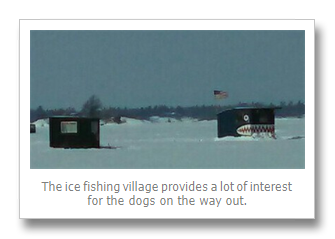Written by
John Kunz posted on February 13, 2016 12:54
Skijoring is a Nordic term that means “Ski Driving.” I like to refer to it as green snowmobiling. Over the past several seasons, we have discovered that this is a spectacular way to enjoy our River during the winter months.
The Thousand Islands are sparsely populated after Labor Day, but once the ice sets up things pick up again. In Chippewa Bay, where we do most of our Skijoring, there is a permanent village of ice fishing shacks just out from the town docks. The shacks are a fascinating collection of structures. Some are elaborately painted while others are quite drab. Several have deer antlers mounted on them. Plumes of smoke identify a few that have small woodstoves inside. Beyond the ice fishing village, there are only the occasional snow machine tracks. Whizzing along behind our pups it is not long till we arrive at vistas that are truly arctic in nature.

The ice fishing village provides a lot of interest for the dogs on the way out. We try hard to stay away from the lines of tip ups. The pups are way too interested in the scraps of bait they find lying around. As we cruise by the village, we get quite a few looks. Skijoring has been around for ages but, we have seen very few people enjoying it in the North County.
It’s about a ten minute skijor from the Chippewa Bay Store to the head of Atlantis Island. Snowmobile tracks make a great trail for the dogs to follow. In the absence of trails, the dogs respond well to voice commands. On the other side of Atlantis sits Ragnavok Island.
The River is nearly 5 miles wide in Chippewa Bay. In midwinter the expanse between the U.S. and Canadian islands might as well be Siberian tundra. When snow falls, the islands disappear in the distance with shades of gray; it gives you the impression that you’re Skijoring into infinity.
We work hard to keep up with the dogs. When they are pulling at a full gallop, we get a really good core work out just trying to stay on our feet. This is especially true when we come across patches of glare ice that have been laid bare by the wind. There is a lot of similarity between Skijoring and waterskiing; with waterskiing, getting up provides a big part of the challenge; with Skijoring staying on your feet is the challenge.
We often stop at our camp on the northern tip of Oak Island for refreshments. Once you’re off the ice, Oak spreads out in a thick hemlock forest. There are several trails that we’ve cleared that provide fast and challenging terrain. On the steeper trails you’re treated to all the excitement of downhill skiing.
Skijoring wooded trails, your footwork needs to be precise and timely. There are some rather dramatic YouTube videos of Skijorers, going the opposite side of trees from their dogs. I am grateful that this has never happened to me or any of my regular trail mates.
A day of Skijoring will take the cabin fever right out of your dogs. The sights and solitude that you will see are so different from our summer experiences. Though they are different, they are a glimpse into a wilderness that not many folks get to see. Gliding by icicle draped rocks that you would normally pass in your skiff is a real treat.
On the night we took this shot, the dogs picked up the trail of a couple of coyotes or coy dogs. We were off to the races, on near perfect snow, out in front of Oak Island.
By John Kunz
John Kunz and his wife Kelly are summer residents of Chippewa Bay. They winter in Watertown, NY. Along with their three sons, they enjoy the River on a four season basis - Sailing, Rock Climbing and Skijoring.